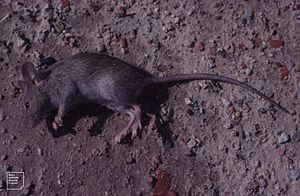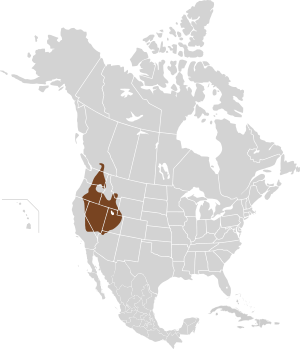Great Basin pocket mouse facts for kids
Quick facts for kids Great Basin pocket mouse |
|
|---|---|
 |
|
| A Great Basin pocket mouse that died of unknown cause | |
| Conservation status | |
| Scientific classification | |
| Genus: |
Perognathus
|
| Species: |
parvus
|
 |
|
| Synonyms | |
|
Perognathus xanthanotus |
|
The Great Basin pocket mouse (Perognathus parvus) is a small rodent that lives in Canada and the western United States. It belongs to a family of mice known for their fur-lined cheek pouches, which they use to carry food.
Contents
Where Great Basin Pocket Mice Live
These pocket mice are found in the Columbia River Basin and the Great Basin areas. Their home stretches from south-central British Columbia in Canada, down through eastern Washington, and south to southeastern California, Nevada, and northern Arizona. You can also find them as far east as southeastern Montana and Wyoming.
There are several different types, or subspecies, of the Great Basin pocket mouse. Each subspecies tends to live in a specific part of this large area. For example, one type lives mostly in Nevada and eastern California, while another lives in south-central British Columbia.
Homes and Habitats
Great Basin pocket mice prefer dry, open areas like steppes and shrublands. They often live in places with sagebrush plants or other desert shrubs. You might also find them in woodlands with pinyon and juniper trees. In some areas, like near the Cascade Range or Sierra Nevada, they can live in forests with ponderosa or Jeffrey pine trees. They might even be more common near rivers than in drier, higher areas.
Life Cycle and Reproduction
When it gets cold in late fall and winter, Great Basin pocket mice stay in their burrows. They enter a state called torpor, which is like a deep sleep, to save energy.
They wake up and start mating in early spring. Males usually come out of their burrows a little before the females. In some areas, they emerge between March and April. Eating fresh, green plants in spring seems to help the females have more babies. Studies have shown that female mice who ate lettuce and seeds had healthier ovaries than those who only ate seeds.
These mice can have one or two litters of babies each year. The first litters are usually born in May, and the second litters in August. A litter can have anywhere from about 4 to 6 babies. The young mice from the first litter leave their burrows in early summer. Babies from the second litter emerge in the fall.
Usually, young mice don't have their own babies until they are a year old. But if there's a lot of food available, some mice from the first litter might be able to breed before winter.
Great Basin pocket mice like to dig their burrows in loose soil. They are active at night and use their burrows to hide during the day. They also use them for their winter and summer torpor. Their winter burrow is deeper, with a tunnel leading to a chamber lined with dry plants. Summer burrows are more shallow. Each mouse usually has its own burrow, except for mothers with their young.
These mice also have a "home range," which is the area they travel to find food and mates. Males often have larger home ranges than females.
What Great Basin Pocket Mice Eat
Great Basin pocket mice mainly eat seeds. They also munch on some green plants and insects, especially before seeds are ready. They don't need to drink water because they get all the water they need from their food.
These clever mice are "scatterhoarders." This means they hide seeds in many small, shallow holes in the ground and cover them with soil. They mostly store seeds from different types of grasses and some wildflowers. Some of their favorite seeds come from plants like Indian ricegrass, cheatgrass, Russian-thistle, antelope bitterbrush, pigweed, and mustard. In years with lots of cheatgrass, its seeds become a very important part of their diet.
However, they avoid areas with a plant called medusahead, and they don't seem to eat its seeds.
A Great Basin pocket mouse eats about 4% to 10% of its body weight in seeds every day. To survive the winter, they need to store about 1.8 to 2.1 ounces (50–60 grams) of seeds. If food is scarce in the summer, they can go into a short period of torpor to save energy.
They are good at finding hidden seeds, even seeds buried by other mice! In one experiment, they found seeds buried just under the surface almost all the time.
Who Eats Great Basin Pocket Mice
Many animals hunt Great Basin pocket mice. These include different types of owls (like northern saw-whet owls and burrowing owls), hawks, coyotes, foxes, weasels, skunks, and snakes.
![]() This article incorporates public domain material from the United States Department of Agriculture document "Perognathus parvus".
This article incorporates public domain material from the United States Department of Agriculture document "Perognathus parvus".


